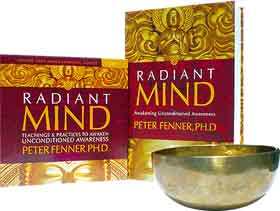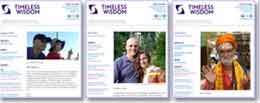Energetic resonance
The Dzogchen tradition has a special term for the way that nondual awareness percolates through the field and gently awakens others to their natural state. They talk about the energetic resonance (thugs rje) of a master, such that when we enter the field of someone who is deeply abiding as boundless awareness, there is a type of energy transference or induction that invites us to enter this very same space.
When we are abiding in the nondual we naturally share this state with others. No effort is required. It’s like two bells resonating together. We don’t even need to speak. By sharing space with others when we’re in unconditioned awareness, we give them the chance to energetically entrain or attune to this space themselves.
Inviting people into our own state of serene completion is one of the greatest gifts we can give others. Particularly when people are upset or agitated, it can be surprising to stay totally connected without buying into the emotions that they are experiencing. Instead we’re fully composed and complete. There’s no rescuing energy, no disapproval or attempt to correct what’s happening. Because we remain connected with them through their disturbance, they become curious. They might think, “Wow. What’s going on for this person? Why isn’t this person trying to sort me out?” This leads the other person to explore what’s really going on. By modeling our experience that there is actually no problem, we silently share our own serenity and lead them to enquire into this experience. They try it on, see how it feels.
Like pure listening, the effectiveness of this entrainment relies on the purity of our unconditioned experience. Regardless of how disturbed another person may be, our experience is uncompromised. This may mean that there is a creative dissonance between ourselves and the other people with whom we are in relationship. This dissonance invites the others to “step up” to meet us where we are at, which is unconditioned awareness. They may not make it all the way to unconditioned awareness on this occasion, but that’s fine. It can happen in steps. The dissonance is useful and, at the same time, we need to watch that we keep other people with us, that it’s not an unreachable stretch for them. If the dissonance is too great, they might perceive us as aloof and so we break rapport.
No separation: one consciousness
In the field of pure awareness there are no selves. There is no boundary between ourselves and others, no point where we stop and others begin. There’s just a seamless field of awareness within which events arise.
As teacher or facilitators, we are not objectifying our student in anyway. This creates intimacy. The communication has a real sense of moment to moment connection. Yet at the same time, we don’t become lost in the story or the feelings that may arise due to this intimacy. Instead we remain fully present in nondual awareness. Being fully present implies letting things be as they are. This space of nondual awareness brings us into the moment. In this moment there can never be a problem, as there is no time in the moment for a problem to occur.
In the sense of time, we are intimate and hearing clearly how the other person is experiencing their problem or challenge and how that exists for them in their mindstream. And at the same time, we’re fully presencing nondual awareness, which is outside of time. We’re resting in the eternal now in which there are no problems. Our intimacy allows the other person easier access to the nondual space. The fact that intimacy and full presence occur simultaneously allows us to move back and forth effortlessly between them. There’s an intimate dance between two people, neither of whom can find themselves or the “other.” It can be delightful.
S: Do you see any benefit in dissolving all of the relative structures into unconditioned awareness?
P: No, none at all.
S: Here, right here, we have the distinctions of subject and object—me and you. This in itself is perfect and complete. But it seems we can also take this further and dissolve the boundaries of self and other, me and you, subject and object.
P: The boundary was never there. We are here and not here as well. If you want, this is the coincident of the absolute and the relative. You’re there. I’m here. You can’t be here because I am here. But if I try and find where I am, I’m nowhere. I can’t find myself. And if you try to find yourself, you can’t find yourself. Nor is there any barrier, or division between you and me. But you’re there, not me!
S: It’s a phenomenological distinction, an experiential distinction, of me being here, and you being there. How do we dissolve that?
P: Again, we don’t need to. It’s not there.
S: The phenomenological boundary can be dissolved.
P: Where is the boundary?
S: I guess the boundary is in the contact, between me and you.
P: Where is the plane of contact?
S: It’s in our relationship with each other.
P: But where am I and where are you?
S: This person (points to himself). And that person (points to Peter).
P: Again. Where are you? Where am I?
S: You’re sitting in that chair. And I’m sitting in this chair.
P: But where is the “I” that experiences you? And where is the “I” that experiences me?
S: I don’t know where you are. But you are still there and I am here.
P: Yes, exactly.
The above article is an excerpt from the Nondual Awakening, Advanced Nondual Training Manual [Pages 77 to 81], a book specially written to learn nondual transmission. Download a PDF of the Table of Content and more abstracts of the Advanced Nondual Training Manual.



